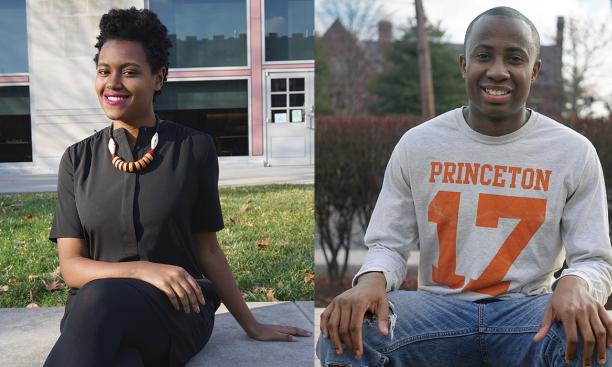
The Black Justice League (BJL), a group of about 15 students, was formed in November 2014 with the goals of “standing in solidarity with Ferguson and dismantling racism on our campus.” After meeting with campus administrators in the months since, the group said, it decided to change tactics, leading to the sit-in in President Eisgruber ’83’s office that began Nov. 18. PAW spoke in early December with two BJL members, Esther Maddox ’17 and Asanni York ’17.
Your group has said you’ve had a decent working relationship with some administrators. When did you decide that occupying the president’s office was the best course of action?
Maddox: The protest that we held that Wednesday was in line with a national and international day of protest across university campuses. The idea was to stand in solidarity with Mizzou [the University of Missouri] and Yale and other universities that were protesting institutional racism on their campuses. The sit-in arose out of the frustration with the University just being extremely slow. So we saw it was necessary to essentially occupy their space in order to get the attention that we thought our cause warranted.
What were your expectations for the protest?
York: The original plan was to occupy [President Eisgruber’s] office around 12-something that day; then we would leave at 5 when he left. Then we would return the next day at 9 a.m. when he arrived; then we would stay till 5 p.m. But on the first day we basically had an administrator tell us that they were going to lock the doors and not allow us to come back in the next day. So we decided if we can’t get back in, we are going to stay.
Maddox: First and foremost, we wanted recognition from the administration that the issues that we were bringing to the table were important and that they necessitated immediate action. We went in with the intent of having Eisgruber sign off on those demands — not necessarily for him to immediately implement those demands, but a commitment from his administration that those demands would be carried out in an expedited manner. We don’t want to see the University drag its feet until we graduate.
When did the legacy of Woodrow Wilson become part of the protest?
York: The discussion around Woodrow Wilson, and the veneration of Woodrow Wilson on this campus, came into the discussion toward the end of the last academic year. After holding several conversations with administrators about what was happening — and what was going to happen and whether anything was going to happen — we brought those demands together, and the Woodrow Wilson demand, to this sit-in.
What do you think of the reactions to the protests — both supporting and opposing you?
Maddox: I wasn’t surprised that there was pushback, especially considering the nature of Princeton University being a very traditionally oriented campus. I knew the things we were presenting were very much putting in question some of those traditions, and maybe even condemning some of those traditions. The thing I was most surprised about was people just not taking the time to fully read and understand our demands. ... People were really tripped up by the Woodrow Wilson demands.
York: It is very frustrating that all of the work we are doing is being reduced to, “Oh, you guys are being disrespectful by sitting in the president’s office.” I and a lot of people in BJL don’t agree with the tone-policing — the belief that you have to be nice to the system in order to get the system changed. Throughout American history that has never been the case. You have to disrupt the system in order for that system to change.
What sort of insults or insensitivity have you encountered on a day-to-day basis at Princeton?
York: I think the stuff that we’ve seen on Yik Yak [a social-media forum with anonymous posts], especially around the time the protest happened, is pretty much indicative of the things you hear day to day. I’ve had experiences where I was at a pregame [party] on the way to an eating club where a white person said he didn’t want to go to the eating club “because that’s where all the niggers hang out.”
Maddox: I’ve had quite a few experiences within the classroom where people were having conversations that were disguised as academic conversations, but were extremely racially charged. I’ve heard students making fun of police brutality. There’s also the view of black people on this campus: People think we were given a free pass to get here — that we didn’t work hard.
What’s it been like for you since the protest?
York: I kind of stay away from all of the social things that I did prior to the sit-in just because of Yik Yak and all of the petitions. I don’t know who wants to sit and smile at my face, but meanwhile they want to go online and write the nastiest comments and the most racist comments about me or about the people in BJL or black students in general — on Yik Yak or in comments on the Prince [website].
Was there a high point of the protest for you?
Maddox: The discussion and conversations that were happening not only on campus, but in this country and across the world, really put into perspective what we had done. ... It validated what I had sat in a room for 33 hours for. It felt like there was something that came out of it.
What do you think of the final agreement with the University administrators?
Maddox: With this university and with all universities, it’s all bureaucracy. We know we’ll need to sit in more meetings and more task forces, but we know at the very least there is pressure on the University to act.
Interview conducted and condensed by Christopher Shea ’91
